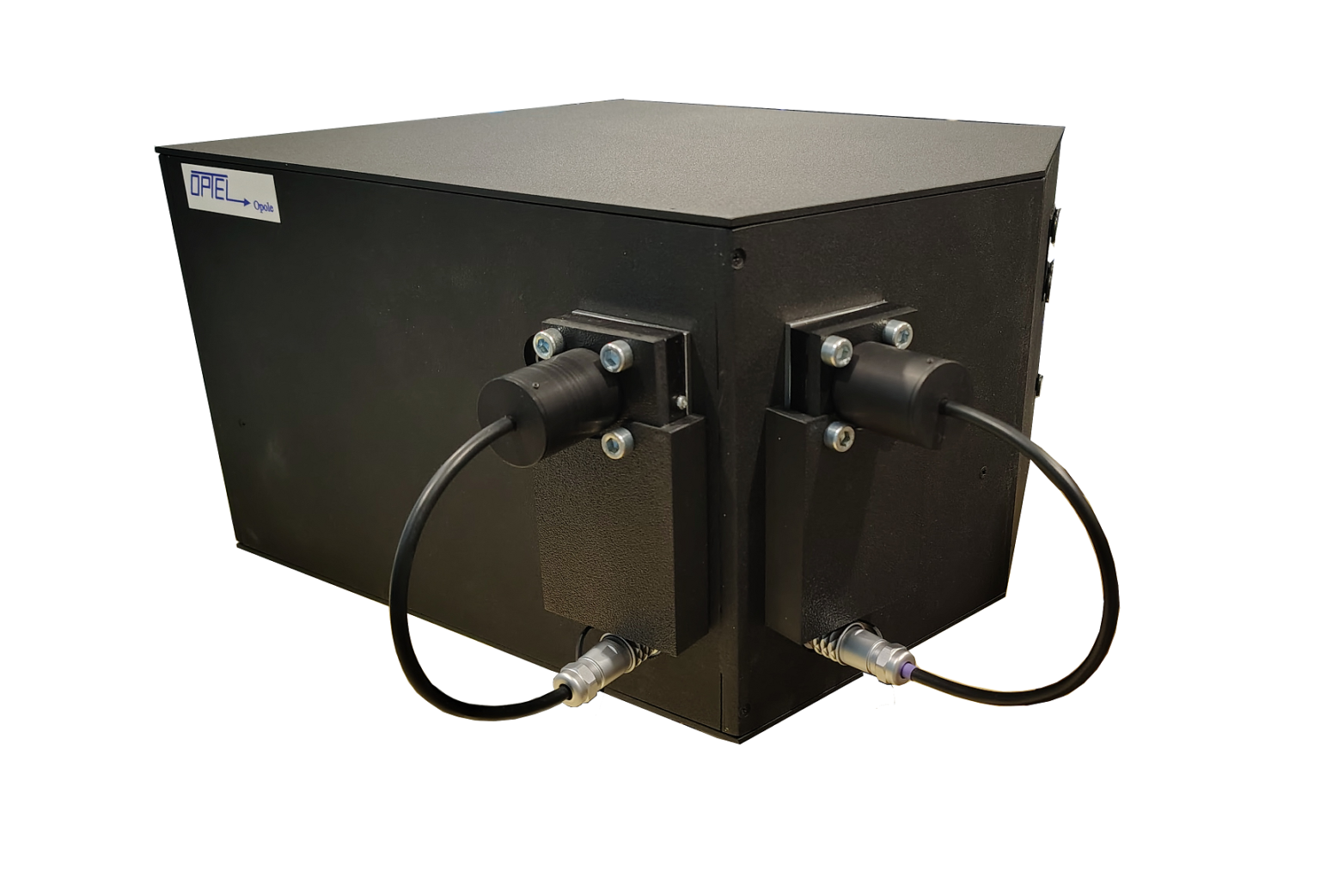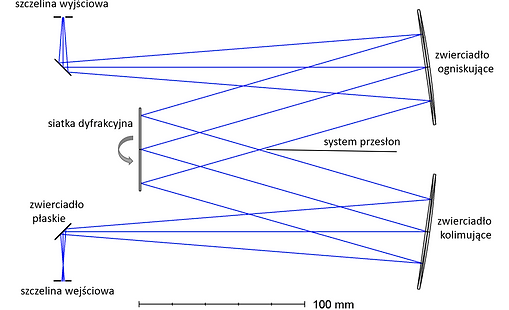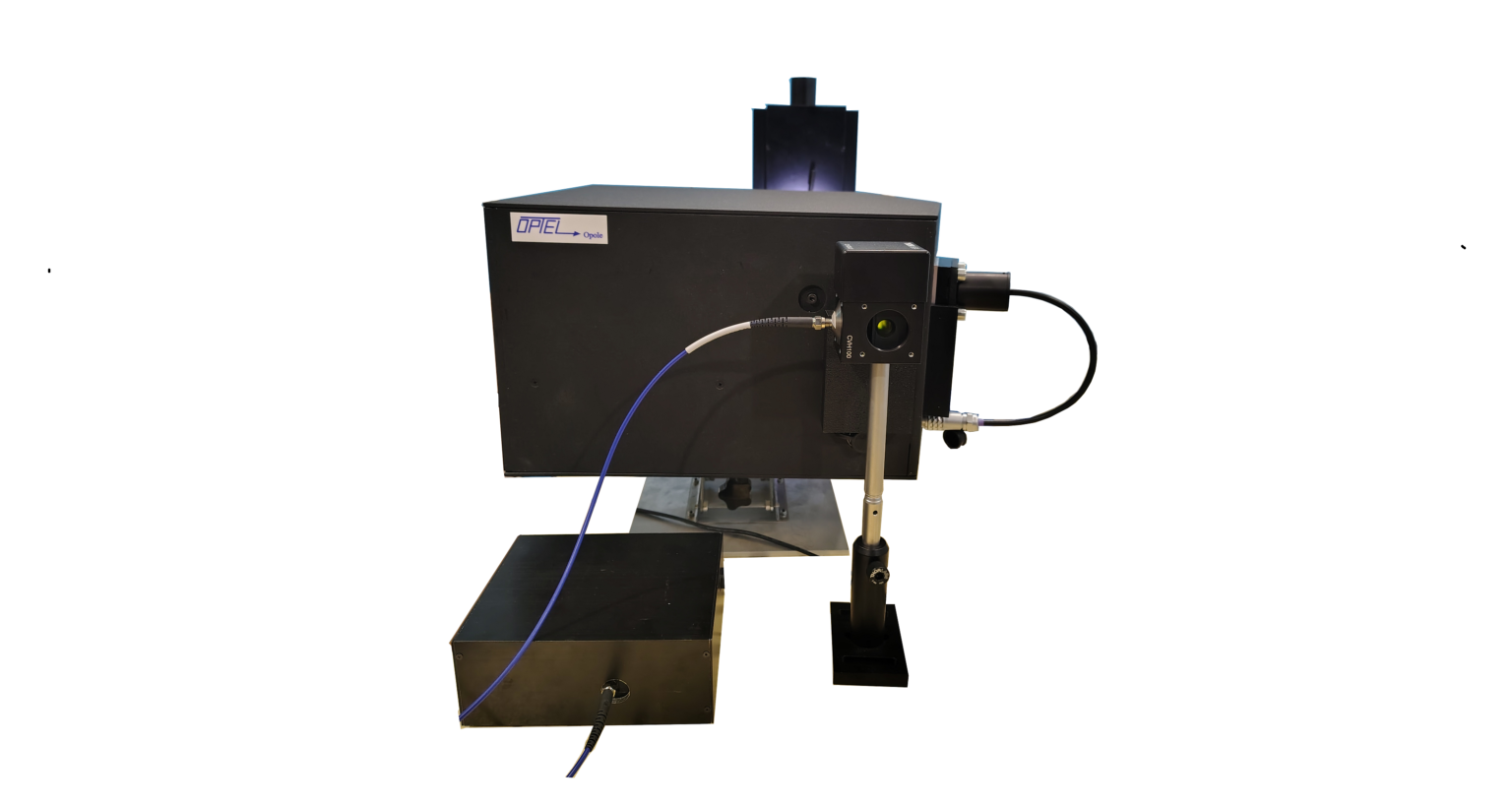Monochromator
Monochromator MO 250
A monochromator is an optical device that splits light, allowing the extraction of a narrow fragment of its spectrum. The wavelength is selected by adjusting the angle of the reflective diffraction grating, while the width of the spectrum is determined by selecting the width of the entrance and exit slits. A monochromator is used in spectral measurements, such as luminescence, absorption or transmission, acting as a tunable light source or an element for spectrum analysis.
In the excitation system, the monochromator is used to select a narrow range of the spectrum of a broadband light source illuminating the entrance slit. In the emission system, it acts as a spectrum analyzer after the light has passed through the sample. In this configuration, a silicon or InGaAs photodiode is placed on the exit slit, which records the scanned spectrum.



The MO 250 monochromator is built in the classic Czerny-Turner system, ensuring high quality of reproduction and precision of operation. The aperture of the monochromator is f/# = 5 and is determined by the focal length of the mirrors, which is 250 mm, and the diameter of the diffraction grating is 50 mm. Such a design minimizes aberrations, while maintaining high intensity of light falling on the diffraction grating.
The monochromator is equipped with automated slits with width adjustment from 0 to 3 mm with an accuracy of 0.01 mm. The slit height is 12.7 mm and is terminated with an SM05 thread, which allows easy integration with additional optical components. The dimensions of the device are 360 × 330 × 200 mm, and its weight is about 12 kg.
Control
The device is equipped with stepper motors with a built-in controller, which allows remote control via USB port. The control software allows full control of the monochromator operation, and detectors can be connected to the controller, maximizing the functionality of the device.
Application and cooperation with other devices
The MO 250 monochromator is adapted to cooperate with OPTEL OPOLE illuminators, creating a tunable light source. To ensure optimal performance, it is necessary to precisely adjust the condenser, which focuses the light on the entrance slit with the appropriate aperture (f/# = 5).
Precision of operation
The accuracy of the monochromator settings depends on the diffraction grating used and is:
- <0.5 nm for a grating with a density of 1200 lines/mm,
- <1 nm for a grating with a density of 600 lines/mm,
- <2 nm for a grating with a density of 300 lines/mm,
in full scanning range.
Optional accessories
A wide range of accessories is available for the MO 250 monochromator, including:
- Detectors,
- Second-order filter holder,
- Sample holders,
- Fiber optic adapters,
- Slit-focusing systems.
Basic configuration:
The MO 250 monochromator in the basic version includes:
One diffraction grating (holder for one grating),
Two automated slits (entrance and exit),
Price: PLN 19,000 net (~EUR 4,500 + VAT).
Additional equipment options:
The user can adapt the monochromator to their needs thanks to a number of additional elements:
- 4-grating holder – allows for mounting up to four diffraction gratings for different wavelength ranges,
- Additional grating assembly and calibration – professional installation and precise calibration,
- Additional entrance and exit slits – increase the flexibility of the system configuration,
- Integrated second-order filter holder (filter wheel) – for effective elimination of higher spectral orders,
- Second-order filter (fi 25.4 mm / 1”) – compatible with the filter holder,
Photodiode mounted on the output slit – available in Si and InGaAs versions, providing high sensitivity in the appropriate spectral ranges, - Elevating table for height adjustment (+45–155 mm) – facilitates integration with other elements of the optical system.
Example advanced configuration:
The MO 250 monochromator, shown in the photo, has been configured as a scanning spectrum analyzer, including:
- An additional exit slit,
- A holder for second-order filters,
- Three diffraction gratings (covering the wavelength range from 250 to 2200 nm),
- Two photodetectors (silicon – Si, and InGaAs – for infrared detection).
This configuration allows for precise spectrum analysis in a wide wavelength range, as well as flexible adaptation to user requirements by using additional accessories.
| Material | Spectral Range [nm] | Details |
|---|---|---|
| UV Enhanced Si | 190 – 1000 | Amplified Si Photodetector from Hamamatsu S1227-16BQ |
| UV Enhanced Si | 200 – 1100 | Amplified Si Photodetector fi 1mm |
| InGaAs | 800 – 1700 | Amplified InGaAs Photodetector fi 1mm |
The spectral range of the device depends on the diffraction grating used. MO 250 monochromators are offered with the following “ruled” reflection diffraction gratings:
| Name | Main Wavelength [nm] | Grating [lines/mm] | Range* [nm] Characteristics | Dyspersion** [nm/mm] |
|---|---|---|---|---|
| 150 | 500 | 150 | 300 – 1100 | 25,6 |
| 300UV | 300 | 300 | 250 – 700 | 12,8 |
| 300IR | 1000 | 300 | 750 – 2000 | 12,8 |
| 600UV | 300 | 600 | 250 – 700 | 6,4 |
| 600VIS | 400 | 600 | 300 – 1000 | 6,4 |
| 600NIR | 750 | 600 | 500 – 1500 | 6,4 |
| 600IR | 1250 | 600 | 900- 2500 | 6,4 |
| 900VIS | 500 | 900 | 350 – 1200 | 4,3 |
| 1200UV | 300 | 1200 | 250- 500 | 3,2 |
| 1200VIS | 400 | 1200 | 300- 750 | 3,2 |
| 1200NIR | 1000 | 1200 | 400- 1500 | 3,2 |
| 1800VIS | 500 | 1800 | 300- 1050 | 2,1 |
* The efficiency in the given range depends on the characteristics of the grating
**The dispersive power is expressed as a spectrum [nm] per the width of the entrance slit [mm] of the monochromator. The value of the dispersive power P is calculated as the ratio of the distance between adjacent grating slits d to the focal length of the mirror system f and is expressed in [nm/mm]. The dispersive power additionally depends on the diffraction angle β and the diffraction order m.
 The long focal length of the M250 monochromators allows for precise wavelength setting.
The long focal length of the M250 monochromators allows for precise wavelength setting.